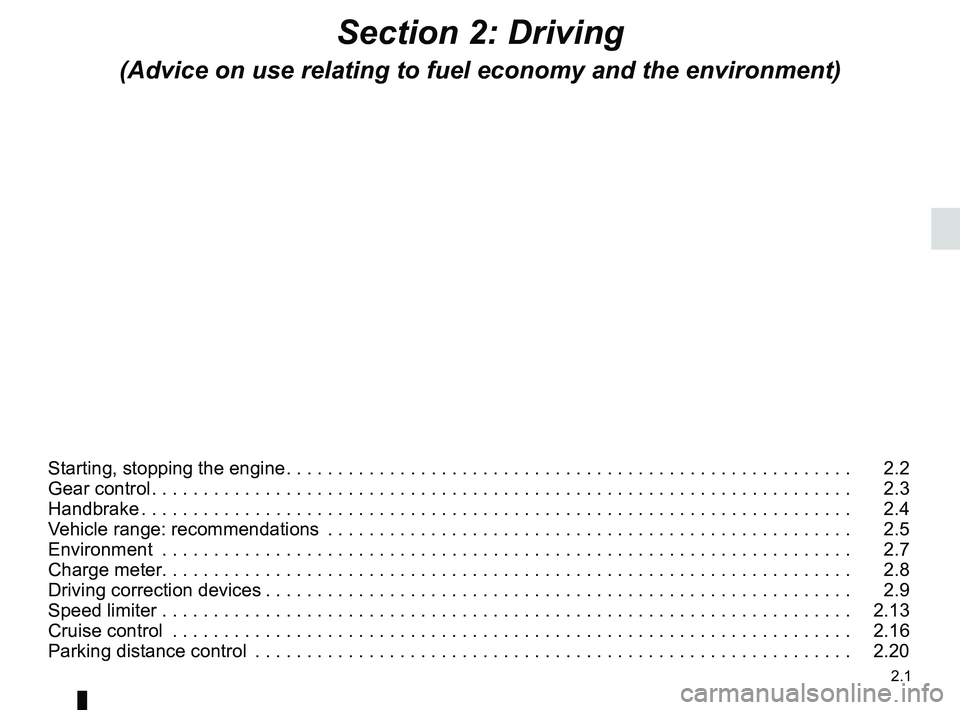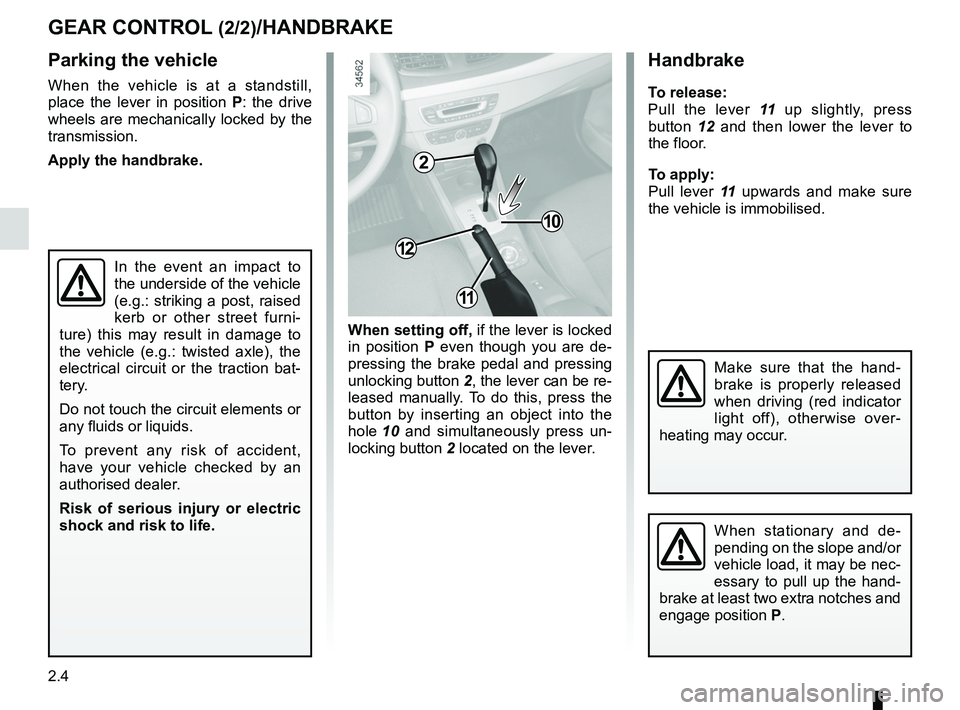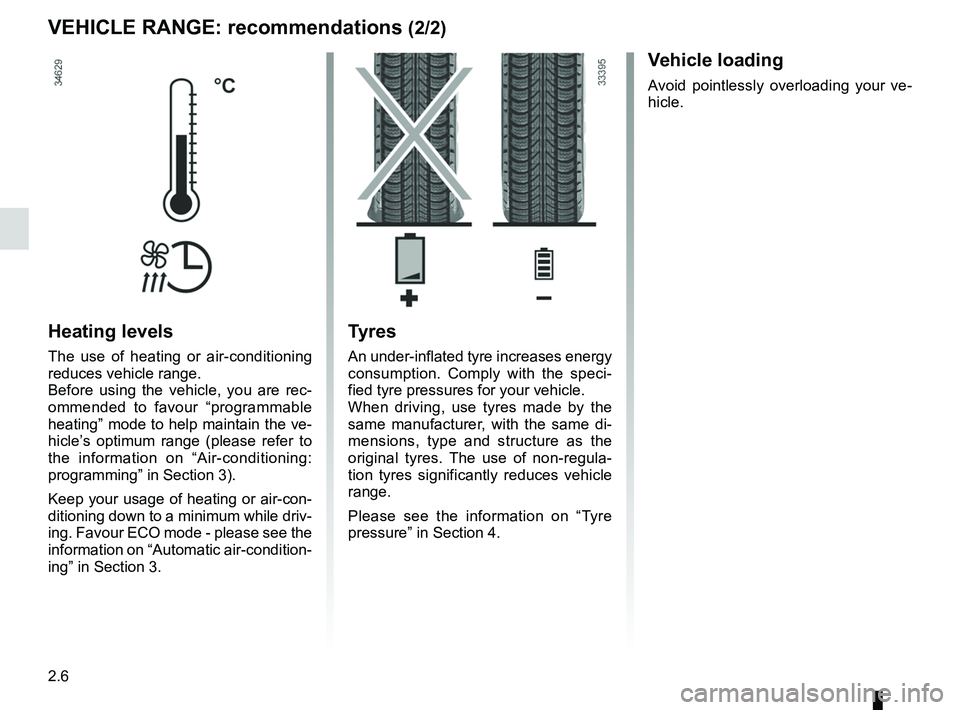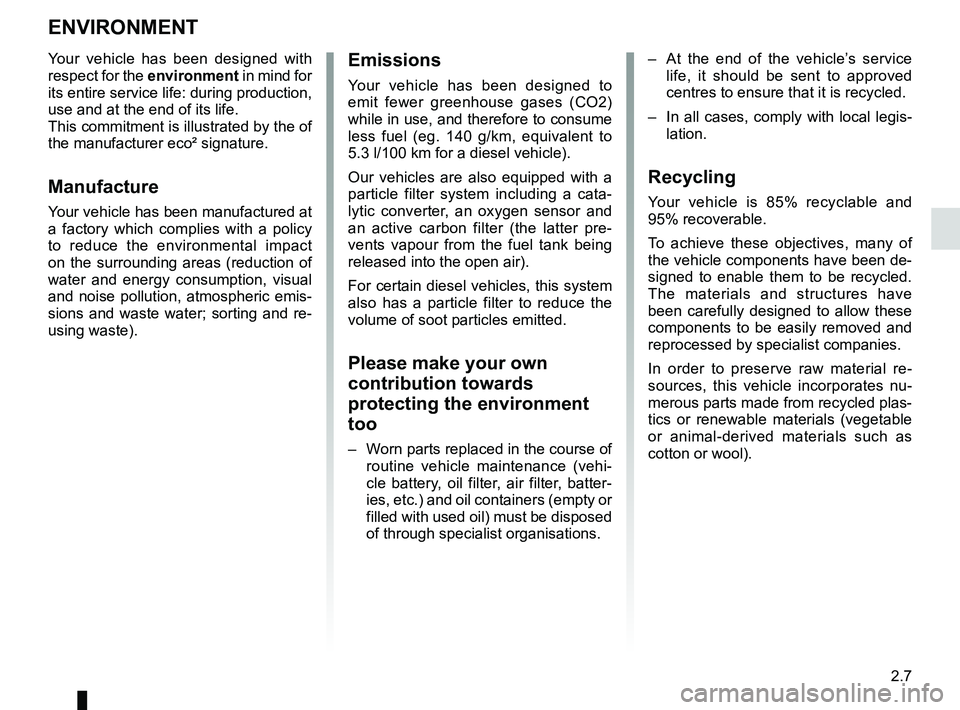RENAULT FLUENCE Z.E. 2012 Manual Online
Manufacturer: RENAULT, Model Year: 2012, Model line: FLUENCE Z.E., Model: RENAULT FLUENCE Z.E. 2012Pages: 195, PDF Size: 5.23 MB
Page 81 of 195

headlight washer ................................................... (current page)
1.76
ENG_UD19237_1
Essuie-vitre / lave-vitre avant (L38 - X38 - Renault)
ENG_NU_914-4_L38e_Renault_1
Windscreen washer
With the ignition on , pull stalk 1 then
release.
A brief pull will trigger a single sweep
of the wipers, in addition to the wind -
screen washer.
A longer pull will trigger three sweeps
of the wipers followed, a few seconds
later, by a fourth, in addition to the wind -
screen washer.
WiNDScreeN WASh/WiPe (2/2)
1
In freezing or snowy weather, ensure
they are not stuck to the windscreen
(including the central area located
behind the interior rear-view mirror)
and the rear screen before starting
the wipers (risk of motor overheat -
ing).
1
A
When working in the engine
compartment, ensure that
the windscreen wiper stalk
is in position A (off).
Risk of injury.
Before any action on the
windscreen (washing the
vehicle, de-icing, cleaning
the windscreen, etc.) return
stalk 1 to position A (off).
Risk of injury and/or damage.
Page 82 of 195

2.1
ENG_UD29437_4
Sommaire 2 (L38 - X38 - Renault)
ENG_NU_914-4_L38e_Renault_2
Section 2: Driving
(Advice on use relating to fuel economy and the environment)
Starting, stopping the engine . . . . . . . . . . . . . . . . . . . . . . . . . . . . . . . . . . . . . . . . . . . . . . . . . . . . . . . 2.2
Gear control . . . . . . . . . . . . . . . . . . . . . . . . . . . . . . . . . . . . . . . . . . . . . . . . . . . . . . . . . . . . . . . . . . . . 2.3
Handbrake . . . . . . . . . . . . . . . . . . . . . . . . . . . . . . . . . . . . . . . . . . . . . . . . . . . . . . . . . . . . . . . . . . . . . 2.4
Vehicle range: recommendations . . . . . . . . . . . . . . . . . . . . . . . . . . . . . . . . . . . . . . . . . . . . . . . . . . . 2.5
Environment . . . . . . . . . . . . . . . . . . . . . . . . . . . . . . . . . . . . . . . . . . . . . . . . . . . . . . . . . . . . . . . . . . . 2.7
Charge meter . . . . . . . . . . . . . . . . . . . . . . . . . . . . . . . . . . . . \
. . . . . . . . . . . . . . . . . . . . . . . . . . . . . . . 2.8
Driving correction devices . . . . . . . . . . . . . . . . . . . . . . . . . . . . . . . . . . . . . . . . . . . . . . . . . . . . . . . . . 2.9
Speed limiter . . . . . . . . . . . . . . . . . . . . . . . . . . . . . . . . . . . . . . . . . . . . . . . . . . . . . . . . . . . . . . . . . . . 2.13
Cruise control . . . . . . . . . . . . . . . . . . . . . . . . . . . . . . . . . . . . . . . . . . . . . . . . . . . . . . . . . . . . . . . . . . 2.16
Parking distance control . . . . . . . . . . . . . . . . . . . . . . . . . . . . . . . . . . . . . . . . . . . . . . . . . . . . . . . . . . 2.20
Page 83 of 195

starting .................................................. (up to the end of the DU)
starting the engine ................................ (up to the end of the DU)
driving ................................................... (up to the end of the DU)
starting the engine ................................ (up to the end of the DU)
stopping the engine .............................. (up to the end of the DU)
2.2
ENG_UD25305_4
Démarrage (L38 électrique - Renault)
ENG_NU_914-4_L38e_Renault_2
Starting, stopping the engine
Start position D
Starting the engine
– Move the gear lever to position P
only ;
– turn the key to position D and re -
lease it.
Warning light
Ṑ may flash on the in -
strument panel, along with a beep. As
soon as light
Ṑ stops flashing and
the beep stops, the vehicle is ready to
drive.
“Stop and steering lock”
position St
To unlock: turn the key and the steering
wheel slightly.
To lock: remove the key and turn the
steering wheel until the steering column
locks.
“Accessories” position AWhen the ignition is switched off, any
accessories (radio, etc.) will continue to
function.
“On” position MThe ignition is switched on:
St Arting, St OPPing the engine
Driver’s responsibility
Never leave your vehi -
cle with the key inside and
never leave a child (or a
pet) unsupervised, even for a short
while.
There is a risk that they could start
the engine or operate electrical
equipment (electric windows etc.)
and trap part of their body (neck,
arms, hands, etc.).
Risk of serious injury.
Never switch off the ignition before
the vehicle has stopped completely.
Once the engine has stopped, the
brake servo, power-assisted steer -
ing, etc., and the passive safety de-
vices such as the airbags and pre -
tensioners will no longer operate.
The vehicle can only be started if
the charging cord is unplugged from
the vehicle.
The vehicle can only be started if
the selection lever is at P. Please
see the information on “Gear con -
trol” in Section 2.
Stopping the engine
Bring the key to “Stop” position.
Warning light
Ṑ goes out.
Page 84 of 195

changing gear ....................................... (up to the end of the DU)
driving ................................................... (up to the end of the DU)
reverse gear selecting .......................................... (up to the end of the DU)
speed control ........................................ (up to the end of the DU)
gear lever .............................................. (up to the end of the DU)
2.3
ENG_UD23027_2
Boîte de vitesse (L38 électrique - Renault)
ENG_NU_914-4_L38e_Renault_2
Driving
Put lever 1 in position D.
The vehicle moves forward once you
release the brake pedal (without press-
ing on the accelerator pedal).
While driving, press the accelerator
pedal to achieve the desired speed.
reverse
Put lever 1 in position r.
The reversing lights will come on as
soon as reverse gear is selected (with
the ignition on).
Gear control
geAr cOntrOl (1/2)
3
2
1
4
5
6
7
8
Operates similar to an automatic gear-
box.
Selector lever 1
The display 3 on the instrument panel
indicates the gear lever position.
4: P: park
5: r: reverse gear
6 : n : neutral
7 : D : forward
8 : display of gear lever position
Operation
With your foot on the brake pedal, the
selection lever 1 in P, switch on the ig-
nition.
Start the motor.
To move out of position P, you must de-
press the brake pedal before pressing
unlocking button 2.
With the foot on the brake pedal (warn-
ing light
c on the display 3 goes out),
move the lever out of position P.
Only engage D or r when the vehi -
cle is stopped, with your foot on the
brake and the accelerator pedal re -
leased.
The vehicle can only start of the
gear selector is in position P.
The vehicle can only be started if
the charging cord is unplugged from
the vehicle.
Page 85 of 195

handbrake.............................................................. (current page)
2.4
ENG_UD23027_2
Boîte de vitesse (L38 électrique - Renault)
ENG_NU_914-4_L38e_Renault_2
Handbrake
Parking the vehicle
When the vehicle is at a standstill,
place the lever in position P: the drive
wheels are mechanically locked by the
transmission.
Apply the handbrake.
geAr cOntrOl (2/2)/hAnDbrAke
When setting off, if the lever is locked
in position P even though you are de -
pressing the brake pedal and pressing
unlocking button 2, the lever can be re-
leased manually. To do this, press the
button by inserting an object into the
hole 10 and simultaneously press un -
locking button 2 located on the lever.
10
2
In the event an impact to
the underside of the vehicle
(e.g.: striking a post, raised
kerb or other street furni -
ture) this may result in damage to
the vehicle (e.g.: twisted axle), the
electrical circuit or the traction bat -
tery.
Do not touch the circuit elements or
any fluids or liquids.
To prevent any risk of accident,
have your vehicle checked by an
authorised dealer.
r isk of serious injury or electric
shock and risk to life.
handbrake
t o release:
Pull the lever 11 up slightly, press
button 12 and then lower the lever to
the floor.
t o apply:
Pull lever 11 upwards and make sure
the vehicle is immobilised.
When stationary and de -
pending on the slope and/or
vehicle load, it may be nec-
essary to pull up the hand -
brake at least two extra notches and
engage position P.
Make sure that the hand -
brake is properly released
when driving (red indicator
light off), otherwise over -
heating may occur.
12
11
Page 86 of 195

driving ................................................... (up to the end of the DU)
practical advice ..................................... (up to the end of the DU)
vehicle range ........................................ (up to the end of the DU)
energy consumption ............................. (up to the end of the DU)
energy saving ....................................... (up to the end of the DU)
electric vehicle vehicle range .................................. (up to the end of the DU)
electric vehicle driving ............................................. (up to the end of the DU)
energy saving .............................................................. (current page)
energy recovery ..................................................... (current page)
2.5
ENG_UD28186_4
Conseils : économie d’énergie (L38 électrique - Renault)
ENG_NU_914-4_L38e_Renault_2
Vehicle range: recommendations
Vehicle rAnge: recommendations (1/2)
The vehicle range is approved for a
mixed NEDC cycle (New European
Driving Cycle).
In real usage, the range of an electric
vehicle may vary depending on several
factors over which you have partial con-
trol, which may make a considerable
difference to the vehicle range. These
factors are:
– speed and driving style;
– type of road;
– heating level;
– tyres;
– vehicle loading.
Speed and driving style
High speeds will reduce your vehicle’s
range.
A “sporty” driving style reduces your
vehicle range: opt for a “lighter” driving
style.
Drive at a constant speed.
Adapt your driving to avoid exces -
sive energy consumption. Please refer
to the “Charge meter” information in
Section 2.
Anticipate traffic changes by lifting your
foot off the accelerator pedal in order
to recover energy. Please refer to the
“Charge meter” information in Section
2.road type
Do not try to maintain the same speed
up a hill, accelerate no more than you
would on the level. Keep your foot in
the same position on the accelerator
pedal.
Page 87 of 195

heating, air conditioning: programming ................. (current page)
2.6
ENG_UD28186_4
Conseils : économie d’énergie (L38 électrique - Renault)
ENG_NU_914-4_L38e_Renault_2
Vehicle rAnge: recommendations (2/2)
heating levels
The use of heating or air-conditioning
reduces vehicle range.
Before using the vehicle, you are rec -
ommended to favour “programmable
heating” mode to help maintain the ve-
hicle’s optimum range (please refer to
the information on “Air-conditioning:
programming” in Section 3).
Keep your usage of heating or air-con-
ditioning down to a minimum while driv-
ing. Favour ECO mode - please see the
information on “Automatic air-condition -
ing” in Section 3.
t yres
An under-inflated tyre increases energy
consumption. Comply with the speci -
fied tyre pressures for your vehicle.
When driving, use tyres made by the
same manufacturer, with the same di -
mensions, type and structure as the
original tyres. The use of non-regula -
tion tyres significantly reduces vehicle
range.
Please see the information on “Tyre
pressure” in Section 4.
Vehicle loading
Avoid pointlessly overloading your ve -
hicle.
Page 88 of 195

environment .......................................... (up to the end of the DU)
2.7
ENG_UD25716_1
Environnement (sans marque) (X44 - X45 - X77 - X81 - X85 - X90 - X91 \
- X83 - X61 - TEST - X95 - J95 - R95 - F90 Ph2 - X33 - X47 - X43 - X38 - H79 - X62 - X32 -\
X09 -
ENG_NU_914-4_L38e_Renault_2
Environment
enVirOnMent
emissions
Your vehicle has been designed to
emit fewer greenhouse gases (CO2)
while in use, and therefore to consume
less fuel (eg. 140 g/km, equivalent to
5.3 l/100 km for a diesel vehicle).
Our vehicles are also equipped with a
particle filter system including a cata -
lytic converter, an oxygen sensor and
an active carbon filter (the latter pre -
vents vapour from the fuel tank being
released into the open air).
For certain diesel vehicles, this system
also has a particle filter to reduce the
volume of soot particles emitted.
Please make your own
contribution towards
protecting the environment
too
– Worn parts replaced in the course of
routine vehicle maintenance (vehi -
cle battery, oil filter, air filter, batter -
ies, etc.) and oil containers (empty or
filled with used oil) must be disposed
of through specialist organisations. –
At the end of the vehicle’s service
life, it should be sent to approved
centres to ensure that it is recycled.
– In all cases, comply with local legis -
lation.
recycling
Your vehicle is 85% recyclable and
95% recoverable.
To achieve these objectives, many of
the vehicle components have been de-
signed to enable them to be recycled.
The materials and structures have
been carefully designed to allow these
components to be easily removed and
reprocessed by specialist companies.
In order to preserve raw material re -
sources, this vehicle incorporates nu -
merous parts made from recycled plas-
tics or renewable materials (vegetable
or animal-derived materials such as
cotton or wool).
Your vehicle has been designed with
respect for the
environment in mind for
its entire service life: during production,
use and at the end of its life.
This commitment is illustrated by the of
the manufacturer eco² signature.Manufacture
Your vehicle has been manufactured at
a factory which complies with a policy
to reduce the environmental impact
on the surrounding areas (reduction of
water and energy consumption, visual
and noise pollution, atmospheric emis-
sions and waste water; sorting and re-
using waste).
Page 89 of 195

charge meter ........................................ (up to the end of the DU)
energy charge meter (function) ................... (up to the end of the DU)
energy consumption ................................... (up to the end of the DU)
energy recovery .......................................... (up to the end of the DU)
2.8
ENG_UD22627_2
Economètre (L38 électrique - Renault)
ENG_NU_914-4_L38e_Renault_2
Charge meter
chArge Meter
A
b
c
D
Ac
D
The traction battery supplies the elec -
trical energy required for the motor to
move the vehicle.
When you lift your foot off the accelera -
tor pedal, the motor generates electri -
cal current during deceleration, and this
energy is used to recharge the traction
battery.
“energy recovery” usage
zone A
Indicates that the vehicle is generating
energy and recharging the battery. energy recovery features
The motor generates a more significant
engine brake than a conventional vehi-
cle.
After a maximum charge for the traction
battery and during the first few miles
when driving the vehicle, the engine
brake is temporarily reduced. Please
adapt your driving style appropriately.
Position
B “neutral”
Indicates nil consumption.
“recommended
consumption” usage zone C
Indicates “economical” energy con -
sumption.
“consumption not
recommended” usage zone D
Indicates high energy consumption.
Page 90 of 195

ABS ...................................................... (up to the end of the DU)
anti-lock braking system: ABS ..............(up to the end of the DU)
ESP: Electronic Stability Program ........ (up to the end of the DU)
ASR (traction control) ........................... (up to the end of the DU)
traction control: ASR .............................(up to the end of the DU)
Electronic Stability Program: ESP ........ (up to the end of the DU)
emergency brake assist ........................(up to the end of the DU)
emergency braking ............................... (up to the end of the DU)
traction control: ASR .............................................. (current page)
driving ................................................... (up to the end of the DU)
2.9
ENG_UD23689_2
Dispositifs de correction de conduite (L38 - X38 - Renault)
ENG_NU_914-4_L38e_Renault_2
AbS (anti-lock braking
system)
Under heavy braking, the ABS prevents
the wheels from locking, allowing the
stopping distance to be managed and
keeping control of the vehicle.
Under these circumstances, the vehi -
cle can be steered to avoid an obstacle
whilst braking. In addition, this system
can increase stopping distances, par -
ticularly on roads with low surface grip
(wet ground etc.).
You will feel a pulsation through the
brake pedal each time the system is
activated. The ABS does not in any way
improve the vehicle’s physical perform-
ance relating to the road surface and
roadholding. It is still essential to follow
the rules of good driving practice (such
as driving at a safe distance from the
vehicle in front etc.).
Driving correction devices
These include:
– t h e A bS ( a n t i - l o c k b r a k i n g
system);
– the electronic stability program
eSP with understeer control and
traction control ASr;
– emergency brake assist with, de -
pending on the vehicle, braking
anticipation.
In an emergency, apply firm and
continuous pressure to the brake
pedal. There is no need to pump
it repeatedly. The ABS will modu -
late the force applied in the braking
system.
These functions are an ad-
ditional aid in the event of
critical driving conditions,
enabling the vehicle behav -
iour to be adapted to suit the driving
conditions.
However, the functions do not take
the place of the driver. they do
not increase the vehicle’s limits
and should not encourage you
to drive more quickly. Therefore,
they can under no circumstances
replace the vigilance or responsibil -
ity of the driver when manoeuvring
the vehicle (the driver must always
be ready for sudden incidents which
may occur when driving).
Yo u r b r a k i n g s y s t e m s
are partially operational.
However, it is dangerous
to brake suddenly and
it is essential to stop immediately,
as soon as traffic conditions allow.
Contact an approved dealer.
Operating faults:
–
© and x lit up on the in -
strument panel alongside, depend -
ing on the vehicle, messages “Check
ABS ”, “Check braking system ” and
“Check ESP”: ABS, ESP and emer-
gency brake assist are deactivated.
braking is always enabled;
–
x, D, © and ® lit
up on the instrument panel alongside
the message “Braking system fault”:
this indicates a fault in the braking
system.
In both cases, consult an approved
Dealer.
DriVer cOrrectiOn DeViceS/AiDS (1/4)